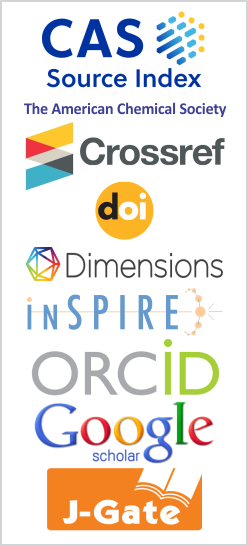Breathing Modes in Rotating Bose-Condensed Gas: An Exact Diagonalization Study
DOI:
https://doi.org/10.26713/jamcnp.v2i2.335Keywords:
Bose-Einstein condensate, Exact diagonalization, Beyond lowest Landau level (LLL) approximation, Breathing mode, Finite-range Gaussian interaction potentialAbstract
We present an exact diagonalization study of the breathing mode collective excitations for a rotating Bose-Einstein condensate of \(N = 10\) spinless bosons interacting via repulsive finiterange Gaussian potential and harmonically confined in quasi-two-dimension. The yrast state and the low-lying excited states are variationally obtained in given subspaces of the quantized total angular momentum \(L\) employing the beyond lowest Landau level approximation in slowly rotating regime with \(0\le L< 2N\). For a given \(L\), the low-energy eigenspectra (bands) are obtained in weakly to moderately interacting regime. Further, for a given interaction, the split in low-lying eigenenergies with increasing \(L\) is the precursor to spontaneous symmetry breaking of the axisymmetry associated with the entry of the first vortex. With increase in repulsive interaction, the value of the first breathing mode increases for stable total angular momentum states \(L = 0\) and \(N\), but decreases for intermediate \(0 < L < N\) metastable states. The position of the observed first breathing modes in the eigenspectrum remains unchanged as the interaction is varied over several orders of magnitude.Downloads
References
M. H. Anderson, J. R. Ensher, M. R. Matthews, C.E. Wieman and E. A. Cornell, Science 269 (1995), 198.
K. B. Davis, M.-O. Mewes, M. R. Andrews, N. J. van Druten, D. S. Durfee, D. M. Kurn and W. Ketterle, Phys. Rev. Lett. 75 (1995), 3969.
C. C. Bradley, C. A. Sackett, J. J. Tollett and R. G. Hulet, Phys. Rev. Lett. 75 (1995), 1687.
D. S. Jin, J. R. Ensher, M. R. Matthews, C. E. Wieman and E. A. Cornell, Phys. Rev. Lett. 77 (1996), 420.
I. Bloch, J. Dalibard and W. Zwerger, Rev. Mod. Phys. 80 (2008), 885.
S. Inouye, M. R. Andrews, J. Stenger, H.-J. Miesner, D. M. Stamper-Kurn and W. Ketterle, Nature (London) 392 (1998), 151.
L. P. Pitaevskii and A. Rosch, Phys. Rev. A 55 (1997), R853.
F. Chevy, V. Bretin, P. Rosenbusch, K. W. Madison and J. Dalibard, Phys. Rev. Lett. 88 (2002), 250402.
F. Dalfovo, S. Giorgini, L. P. Pitaevskii and S. Stringari, Rev. Mod. Phys. 71 (1999), 463.
C. R. McDonald, G. Orlando, J. W. Abraham, D. Hochstuhl, M. Bonitz, and T. Brabec, Phys. Rev. Lett. 111 (2013), 256801.
F. Serwane, G. Zürn, T. Lompe, T. B. Ottenstein, A. N. Wenz and S. Jochim, Science 332 (2011), 336.
E. Haller, R. Hart, M. J. Mark, J. G. Danzl, L. Reichsöllner, M. Gustavsson, M. Dalmonte, G. Pupillo and H.-C. Nägerl, Nature (London) 466 (2010), 597.
C.G. Bao, Y. Z. He, G. M. Huang and T. Y. Shi, Phys. Rev. A 65 (2002), 022508.
M. Olshanii, H. Perrin and V. Lorent, Phys. Rev. Lett. 105 (2010), 095302.
J. Christensson, C. Forssén, S. í…berg and S. M. Reimann, Phys. Rev. A 79 (2009), 012707.
R. A. Doganov, S. Klaiman, O. E. Alon, A. I. Streltsov and L. S. Cederbaum, Phys. Rev. A 87 (2013), 033631.
E. R. Davidson, J. Comput. Phys. 17 (1975), 87.
M. A. H. Ahsan and N. Kumar, Phys. Rev. A 64 (2001), 013608.
T. Nakajima and M. Ueda, Phys. Rev. Lett. 91 (2003), 140401.
Downloads
Published
How to Cite
Issue
Section
License
Authors who publish with this journal agree to the following terms:- Authors retain copyright and grant the journal right of first publication with the work simultaneously licensed under a CCAL that allows others to share the work with an acknowledgement of the work's authorship and initial publication in this journal.
- Authors are able to enter into separate, additional contractual arrangements for the non-exclusive distribution of the journal's published version of the work (e.g., post it to an institutional repository or publish it in a book), with an acknowledgement of its initial publication in this journal.
- Authors are permitted and encouraged to post their work online (e.g., in institutional repositories or on their website) prior to and during the submission process, as it can lead to productive exchanges, as well as earlier and greater citation of published work.




